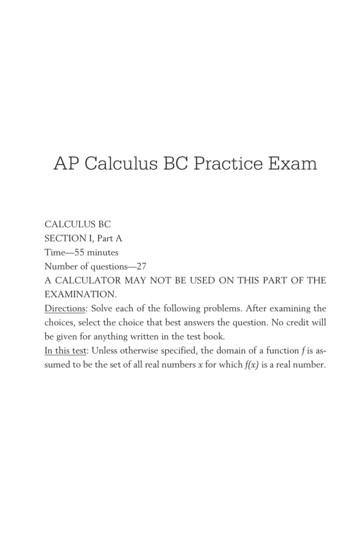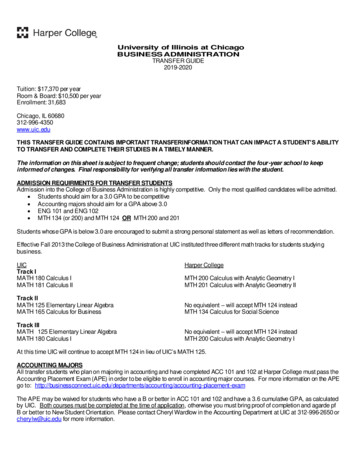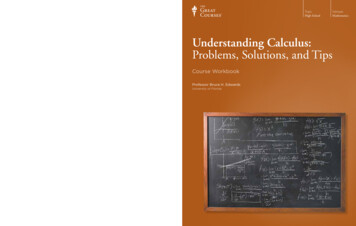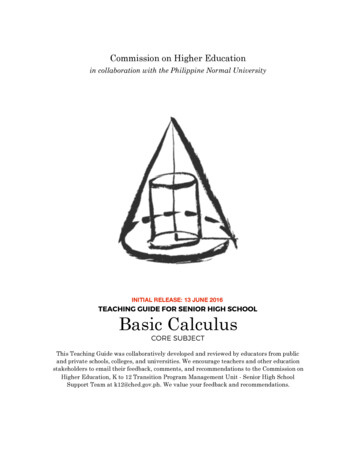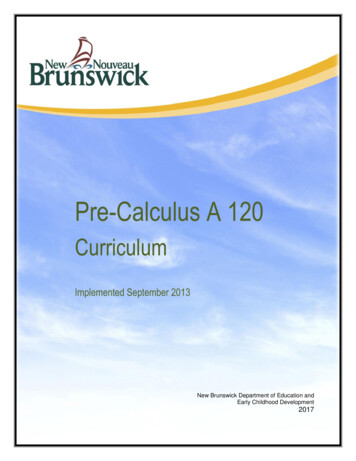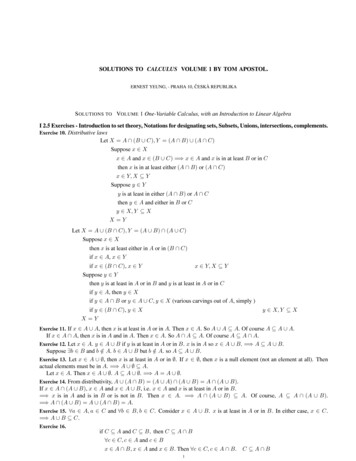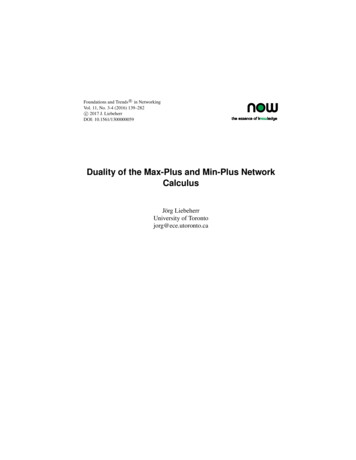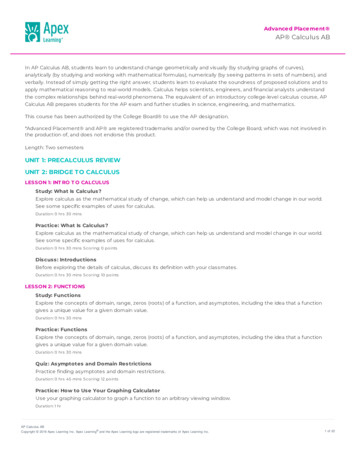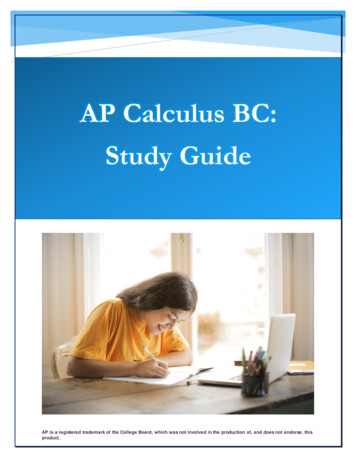
Transcription
AP Calculus BC:Study GuideAP is a registered trademark of the College Board, which was not involved in the production of, and does not endorse, thisproduct.
Key Exam DetailsThe AP Calculus BC exam is a 3-hour 15-minute, end-of-course test comprised of 45 multiplechoice questions (50% of the exam) and 6 free-response questions (50% of the exam).The exam covers the following course content categories: Limits and Continuity: 4–7% of test questionsDifferentiation: Definition and Fundamental Properties: 4–7% of test questionsDifferentiation: Composite, Implicit, and Inverse Functions 4–7% of test questionsContextual Applications of Differentiation: 6–9% of test questionsAnalytical Applications of Differentiation: 8–11% of test questionsIntegration and Accumulation of Change: 17–20% of test questionsDifferential Equations: 6–9% of test questionsApplications of Integration: 6–9% of test questionsParametric Equations, Polar Coordinates, and Vector-Valued Functions: 11–12% of testquestionsInfinite Sequences and Series: 17–18% of test questionsThis guide offers an overview of the main tested subjects, along with sample AP multiple-choicequestions that look like the questions you’ll see on test day.Limits and ContinuityAbout 4–7% of the questions on your exam will cover Limits and Continuity.LimitsThe limit of a function f as x approaches c is L if the value of f can be made arbitrarily close to Lby taking x sufficiently close to c (but not equal to c). If such a value exists, this is denotedlim f ( x) L . If no such value exists, we say that the limit does not exist, abbreviated DNE.x cLimits can be found using tables, graphs, and algebra.Important algebraic techniques for finding limits include factoring and rationalizing radicalexpressions. Other helpful tools are given by the following properties.Suppose lim f ( x) L , lim g ( x) M , lim h( x) N , and a is any real number.x cx cx L1
Then: lim f ( x) g ( x) L M lim f ( x) g ( x) L M lim af ( x) aL lim lim h ( f ( x) ) Nx cx cx cx cf ( x) L , as long as M 0g ( x) Mx cFor many common functions, evaluating limits requires nothing more than evaluating thefunction at the point c (assuming the function is defined at the point). These include polynomial,rational, exponential, logarithmic, and trigonometric functions.Two special limits that are important in calculus are limx 0sin x1 cos x 1 and lim 0.x 0xxOne-Sided LimitsSometimes we are interested in the value that a function f approaches as x approaches c fromonly a single direction. If the values of f get arbitrarily close to L as x approaches c while takingon values greater than c, we say lim f ( x) L . Similarly, if x is taking on values less than c, wex cwrite lim f ( x) L .x cWe can now characterize limits by saying that lim f ( x) exists if and only if both lim f ( x) andx cx clim f ( x) exist and have the same value. A limit, then, can fail to exist in a few ways:x c lim f ( x) does not existx c lim f ( x) does not existx c Both of the one-sided limits exist, but have different values2
ExampleThe function shown has the following limits: lim f ( x) 1x 2 lim f ( x) 1x 2 lim f ( x) DNEx 2lim f ( x) 4x 1 lim f ( x) 4x 1 lim f ( x) 4x 1Note that f(1) 3, but this is irrelevant to the value of the limit.Infinite Limits, Limits at Infinity, and AsymptotesWhen a function has a vertical asymptote at x c, the behavior of the function can be describedusing infinite limits. If the function values increase as they approach the asymptote, we say thelimit is , whereas if the values decrease as they approach the asymptote, the limit is - . It isimportant to realize that these limits do not exist in the same sense that we described earlier;rather, saying that a limit is is simply a convenient way to describe the behavior of thefunction approaching the point.We can also extend limits by considering how the function behaves as x . If such a limitexists, it means that the function approaches a horizontal line as x increases or decreases withoutbound. In other words, if lim f ( x) L , then f has a horizontal asymptote y L . It is possible forx a function to have two horizontal asymptotes since it can have different limits asx .3x and
The Squeeze TheoremThe Squeeze Theorem states that if the graph of a function lies between the graphs of two otherfunctions, and if the two other functions share a limit at a certain point, then the function inbetween also shares that same limit. More formally, if f ( x) g ( x) h( x) for all x in someinterval containing c, and if lim f ( x) lim h( x) L , then lim g ( x) L as well.x cx cx cExample 1 The sine function satisfies 1 sin x 1 for all real numbers x, so 1 sin 1 is also true x 1 for all real numbers x. Multiplying this inequality by x 2 , we obtain x 2 x 2 sin x 2 . Now x 22the functions on the left and right of the inequality, x and x , both have limits of 0 as x 0 . 1 Therefore, we can conclude that lim x 2 sin 0 also.x 0 x ContinuityThe function f is said to be continuous at the point x c if it meets the following criteria:1. f (c) exists2. lim f ( x) existsx c3. lim f ( x) f (c)x cIn other words, the function must have a limit at c, and the limit must be the actual value of thefunction.Each of the above criteria can fail, resulting in a discontinuity at x c. Consider the followingthree graphs:4
In graph A, the function is not defined at c. In graph B, the function is defined at c, but the limitas x c does not exist due to the one-sided limits being different. In graph C, the function isdefined at c and the limit as x c exists, but they are not equal to each other.The discontinuity in graph B is referred to as a jump discontinuity, since it is caused by the graphjumping when it reaches x c. In contrast to this is the situation in graph C, where thediscontinuity could be fixed by moving a single point; it occurs whenever the second conditionabove is satisfied and is called a removable discontinuity. If lim f ( x) exists, but f has ax cdiscontinuity at x c because it fails one of the other conditions, the discontinuity can beremoved by defining or redefining f(c) to be equal to the limit at that point.A function is continuous on an interval if it is continuous at every point in the interval. Thefollowing categories of functions are continuous at every point in their respective domains: nometricIf f is a piecewise-defined function with continuous component functions, then checking forcontinuity consists of checking whether it is continuous at its boundary points. Continuity at aboundary point requires that the functions on both sides of the point give the same result whenevaluated at the point.Intermediate Value TheoremThe Intermediate Value Theorem applies to continuous functions on an interval a, b . If d is anyvalue between f(a) and f(b), then there must be at least one number c between a and b such thatf(c) d.ExampleConsider f ( x) e x 2 , which is continuous everywhere. We have f (0) e0 2 1 , and f(1) e – 2, which is certainly positive. If we take d 0 in the statement of the theorem, then d isbetween f(0) and f(1). Therefore, the Intermediate Value Theorem guarantees at least one value cbetween 0 and 1 with the property that f (c) 0 . This value, of course, is c ln 2 .5
Suggested Reading Hughes-Hallett, et al. Calculus: Single Variable. 7thedition. Chapter 1. New York, NY: Wiley.Larson & Edwards. Calculus of a Single Variable: EarlyTranscendental Functions. 7th edition. Chapter 2. Boston,MA: Cengage Learning.Stewart, et al. Single Variable Calculus. 9th edition.Chapter 2. Boston, MA: Cengage Learning.Rogawski, et al. Calculus: Early Transcendentals SingleVariable. 4th edition. Chapter 2. New York, NY:Macmillan.Sullivan & Miranda. Calculus: Early Transcendentals. 2ndEdition. Chapter 1. New York, NY: W.H. Freeman.Sample Limits and Continuity QuestionsConsider the following graphs of f and g:Compute lim 3 f ( x) g ( x) , provided the limit exists.x 2A. Does not existB. 4C. 6D. 7Explanation:The correct answer is D. First, use linearity to write:lim 3 f ( x) g ( x) 3 lim f ( x) lim g ( x) .x 2 x 26x 2
Now, observe that lim f ( x) 3 and lim g ( x) 2 . Substituting these values above yieldsx 2x 2lim 3 f ( x) g ( x) 3 lim f ( x) lim g ( x) 3(3) 2 7 .x 2 x 2x 2Suppose that f ( x) 2 cos ( 3 x ) and the graph of g(x) is given byCompute lim f ( x) g ( x) , provided it exists.x 3A. –6B. 4C. 6D. Does not existExplanation:The correct answer is C. Use the fact that the limit of a product is the product of the limits,provided they both exist independently, to compute:()(lim f ( x) g ( x) lim f ( x) lim g ( x)x 3x 3x 3 ( 2 cos ( 3 ( 3) ) ) ( 3) ( 2 cos ( ) ) ( 3) ( 2 )( 3) 6Which of the following limits does not exist?7)
sin xx x x 1 B. limx 1 1 x2C. lim x 3A. limx 0D. lim sec xx Explanation:The correct answer is B. Recall that x 1, x 1 x 1 1 x, x 1So, x 1 1, x 1 1 x 1, x 1 x 1 x 1 Hence, lim 1 while lim 1 . Since these values are different, it follows thatx 1x 11 x1 x x 1 there is a jump at x 1 and so, limdoes not exist.x 1 1 x8
Differentiation: Definition andFundamental PropertiesAbout 4–7% of the questions on your AP exam will cover Differentiation: Definition andFundamental Properties.Definition of the DerivativeThe average rate of change of a function f over the interval from x a to x a h isf ( a h) f ( a )f ( x) f (a ). Alternatively, if x a h , this can be written. When h is madehx asmaller, so that it approaches 0, the limit that results is called the instantaneous rate of change off at x a , or the derivative of f at x a , and is denoted f (a) .f ( a h) f ( a )f ( x) f ( a )That is, f (a) lim, or equivalently, f (a) lim.h 0x ahx aIf this limit exists, f is said to be differentiable at a. Graphically, f (a) represents the slope of theline tangent to the graph of f ( x) at the point where x a . Therefore, the line tangent to f(x) at x a is y f (a) f (a)( x a) .If the function y f ( x) is differentiable at all points in some interval, we can define a newfunction on that interval by finding the derivative at every point. This new function, called thedyf ( x h) f ( x )derivative of f, can be denoted f ( x) , y , or, and is defined by f ( x) lim.h 0hdxdyThe value of the derivative at a particular point x a can then be denoted f (a) ordx x aIf f is differentiable at x a , then it also must be continuous at x a . In other words, if afunction fails to be continuous at a point, it cannot possibly be differentiable at that point.Another way that differentiability can fail is via the presence of sharp turns or cusps in a graph.Free Response TipWhen specific function values are given, thederivative at a point can be approximated byfinding the average rate of change betweensurrounding points. For example, if you aregiven values of a function at x 3, 4, and 5, thenthe derivative at 4 can be approximated by theaverage rate of change between 3 and 5.9
Basic Derivatives and RulesThere are several rules that can be used to find derivatives. Assume f and g are differentiablefunctions, and c is a real number.d The constant rule:c 0dxd n The power rule:x nx n 1 , for any real number ndxd The sum rule: f ( x) g ( x) f ( x) g ( x)dxd The difference rule: f ( x) g ( x) f ( x) g ( x)dxd The constant multiple rule: cf ( x) cf ( x)dxd The product rule: f ( x) g ( x) f ( x) g ( x) f ( x) g ( x)dxd f ( x) f ( x) g ( x) f ( x) g ( x) The quotient rule: 2dx g ( x) g ( x) As special cases of the power rule, note thatdd( cx ) c , and x 1 .dxdxIn addition to these rules, the derivatives of some common functions are as follows:f ( x)f(x)exln xsin xcos xtan xsec xcsc xcot xxe1xcos x sin xsec2 xsec x tan x csc x cot x csc2 x10
Suggested Reading Hughes-Hallett, et al. Calculus: Single Variable. 7thedition. Chapters 2 and 3. New York, NY: Wiley.Larson & Edwards. Calculus of a Single Variable: EarlyTranscendental Functions. 7th edition. Chapter 3. Boston,MA: Cengage Learning.Stewart, et al. Single Variable Calculus. 9th edition.Chapters 2 and 3. Boston, MA: Cengage Learning.Rogawski, et al. Calculus: Early Transcendentals SingleVariable. 4th edition. Chapter 3. New York, NY:Macmillan.Sullivan & Miranda. Calculus: Early Transcendentals.2nd Edition. Chapter 2. New York, NY: W.H. Freeman.Sample Differentiation: Definition and Fundamental PropertiesQuestionsBoyle’s laws states that if a gas is compressed by constant temperature, the product of thevolume and pressure remains constant; that is, VP K, where K is a constant. Which of thefollowing equals the instantaneous rate of change of pressure with respect to volume?A. –KB. 0C. KV 2KD. 2VExplanation:The correct answer is D. Observe that since VP K, it follows that P KV 1 . DifferentiatingdPK KV 2 2 .both sides with respect to V yieldsdVV11
11An object moves along the curve y , starting at x . As it passes through the point (1,1) itsx10x-coordinate increases at a rate of 2 inches per second. How fast is the distance between theobject and the origin changing at this instance in time?A. 0 inches per secondB. 4 2 inches per secondC. 2 inches per secondD. –2 inches per secondExplanation:The correct answer is A. The position of a point on this curve is of the form ( x, y ) ( x, 1x ) . So,the distance D between it and the origin isD ( x 0) ( y 0)22 ( x 0 ) ( 1x 0 )22 x 2 x 2 .While we could differentiate both sides with respect to t directly, the presence of the radicalmakes this inconvenient. So, we square both sides first to get D2 x 2 x 2 and now differentiateboth sides with respect to t. Doing so yields:dDdxdx2D 2 x 2 x 3dtdtdtdDdxdxD x x 3dtdtdtNote that when the object is at the point (1,1), we know that x 1, D 12 1 2 2 , anddx 2 inches per second. Substituting this information into the above equation yieldsdtdD2 1 2 1 2 0 .dtSo,dD 0.dtFor how many values of x in the interval 0, 2 is the tangent line to the curveg ( x) sec x csc x parallel to the line x y?A. 0B. 2C. 3D. 412
Explanation:The correct answer is B. First, use the graphing calculator to graph g(x) on 0, 2 :Now, reasoning using the continuity of the graph and the vertical asymptotes reveals that theremust be tangent lines to g(x) with slope 1 at one x-value in each of the following intervals: ( a , 2 )and ( , c ) .13
Differentiation: Composite, Implicit, andInverse FunctionsAbout 4–7% of the questions on your exam will cover the topic Differentiation: Composite,Implicit, and Inverse Functions.Chain RuleThe chain rule makes it possible to differentiate composite functions. If y f ( g ( x)) , then thechain rule states that y f ( g ( x)) g ( x) . In alternative notation, if y f (u) and u g ( x) , thendy dy du .dx du dxThe chain rule can be extended to compositions of more than two functions by considering thatg ( x) as described above may itself be a composition. If y f ( g (h( x))) , two applications of thechain rule yield y f ( g (h( x))) g (h( x)) h ( x) .Implicit Differentiation and Inverse FunctionsA function may sometimes be presented in implicit, rather than explicit, form. That is, it may notbe given as y f ( x) , but rather as an equation that relates x and y to each other. In such cases,we say that y is implicitly defined as a function of x . Implicit differentiation is the process ofdyfinding the derivativefor such functions, and it is accomplished by applying the chain rule.dxExampleConsider the equation y3 x3 xy 5 . Differentiating both sides of the equation with respect tox, and remembering that we are assuming that y is, in fact, a function of x (so that the chain ruleapplies), we getd 3dy x3 xy 5 ) ( 5 )(dxdxdydy3 y 2 3 x 2 1 y x 1 0dxdx14
Note that differentiating xy required an application of the product rule, and that every time andyexpression in terms of y was differentiated, the derivative was multiplied by. Now all of thedxdydyterms withcan be gathered on one side of the equation, andcan be solved for:dxdx3y2 dydy x y 3x 2dxdxdy3 y 2 x ) y 3x 2(dxdy y 3 x 2 dx 3 y 2 xThis technique can also be applied to find the derivatives of inverse functions. Consider aninvertible function f, with inverse f 1 . By definition this means that f ( f 1 ( x) ) x . Now,differentiating both sides with respect to x, we get f ( f 1 ( x) ) ( f 1 ) ( x) 1 . Solving for( f ) ( x) , we have ( f ) ( x) 1 11f ( f 1 ( x) ).Applying this rule to the inverse trigonometric functions, we can find the following derivatives:f farcsin x1arccos x1 x2 1arcsec x1 x211 x2 11 x21arccsc xx x2 1 1arctan xarccot xx x2 115
Higher Order DerivativesThe derivative f of a function f is itself a function that may be differentiable. If it is, then itsderivative is f , called the second derivative of f. The relationship of f and f is identical tothe relationship between f and f . Similarly, the derivative of f is f , the third derivative off. This process can continue indefinitely, as long as the functions obtained continue to bedifferentiable. After three, the notation changes, so that the 4 th derivative of f is denoted f (4) ,and the nth derivative is f ( n ) .If y f ( x) , then higher order derivatives are also denoted y , y , y (4) , , y ( n) , , ord2y d3ydny,, , n , dx 2 dx3dxSuggested Reading Hughes-Hallett, et al. Calculus: Single Variable. 7thedition. Chapter 3. New York, NY: Wiley.Larson & Edwards. Calculus of a Single Variable: EarlyTranscendental Functions. 7th edition. Chapter 3. Boston,MA: Cengage Learning.Stewart, et al. Single Variable Calculus. 9th edition.Chapter 3. Boston, MA: Cengage Learning.Rogawski, et al. Calculus: Early Transcendentals SingleVariable. 4th edition. Chapter 3. New York, NY:Macmillan.Sullivan & Miranda. Calculus: Early Transcendentals. 2ndEdition. Chapter 3. New York, NY: W.H. Freeman.16
Sample Differentiation: Composite, Implicit, and Inverse FunctionsQuestionsSuppose f(x) is a differentiable function, f(2) - p6 , and f (2) 1.2If y cos(f(x)), compute(2).A. sin ( 21 )B. cos ( 21 )C.D.1412Explanation:The correct answer is C. First, compute the derivative using the chain rule:dy sin(f ( x )) f ( x )dxNow, substitute x 2 and use the information provided:dy(2) sin(f (2)) f (2)dx sin ( 6 ) ( 21 ) 121214 1What is the equation of the tangent line to f ( x ) sin( x ) at x 14( x 41 )B. y 6 2 33 ( x 41 )C. y 6 41515 ( x 41 )D. y 3 41515 ( x 41 )A. y 3 2 33Explanation:The correct answer is B. First, use the chain rule to compute f ( x ) :1111f ( x ) 2 2 x1 x 2 x1 x( )Now, evaluate this expression at x 41 :17?dydx
f ( 41 ) 11 1 41 2 14134 1 132 2 33This is the slope of the tangent line at x 41 . To get the y-value of the point of tangency,compute f ( 41 ) :f ( 41 ) sin 1( ) sin14( ) 6 1 12So, using the point-slope form for the equation of a line, the equation of the tangent line isy 6 2 33( x 41 ) .What is the slope of a line perpendicular to the tangent line to the curve defined implicitly byx2y2 – xy 42 at the point (2, –3)?A.B.C.D.326 32 26332Explanation:The correct answer is B. This is the correct answer. Implicitly differentiate both sides withrespect to x:x 2 2y y y 2 2x ( xy y ) 02 x 2 y y 2xy 2 xy y 0()y 2 x 2 y x y 2xy 2y 2 xy 22x 2 y xy (1 2 xy )y x(2 xy 1)yy xSo, the slope of the tangent line at the point (2, –3) is ( 3 ) 3 . Therefore, any line perpendiculary 22to the tangent line at this point would have a slope equal to 32 .18
Contextual Applications of DifferentiationAround 6–9% of the questions on your AP exam will cover the topic Contextual Applications ofDifferentiation.In any context, the derivative of a function can be interpreted as the instantaneous rate of changeof the independent variable with respect to the dependent variable. If y f ( x) , then the units ofthe derivative are the units of y divided by the units of x.Straight-Line MotionRectilinear (straight-line) motion is described by a function and its derivatives.If the function s(t ) represents the position along a line of a particle at time t, then the velocity isgiven by v(t ) s (t ) . When the velocity is positive, the particle is moving to the right; when it isnegative, the particle is moving to the left. The speed of the particle does not take direction intoaccount, so it is the absolute value of the velocity, or v (t ) .The acceleration of the particle is a(t ) v (t ) s (t ) . The velocity is increasing when a(t ) ispositive and decreasing when a(t ) is negative. The speed, however, is only increasing whenv(t ) and a(t ) have the same sign (positive or negative). When v(t ) and a(t ) have differentsigns, the particle’s speed is decreasing.Related RatesRelated rates problems involve multiple quantities that are changing in relation to each other.Derivatives, and especially the chain rule, are used to solve these problems. Though theproblems vary widely with context, there are a few steps that usually lead to a solution.1.2.3.4.5.Draw a picture and label relevant quantities with variables.Express any rates of change given in the problem as derivatives.Express the rate of change you need to solve for as a derivative.Relate the variables involved in the rates of change to each other with an equation.Differentiate both sides of the equation with respect to time. This may involve applyingmany derivative rules but will always involve the chain rule.6. Substitute all of the given information into the resulting equation.7. Solve for the unknown rate.ExampleThe length of the horizontal leg of a right triangle is increasing at a rate of 3 ft/sec, and the lengthof the vertical leg is decreasing at a rate of 2 ft/sec. At the instant when the horizontal leg is 7 ftand the vertical leg is 1 ft, at what rate is the length of the hypotenuse changing? Is it increasingor decreasing?19
We will follow the steps given above.1.dxdy 3 and 2dtdtdz3. We need to finddt x 7, y 12. We are given4. x, y, and z are related by the Pythagorean theorem: x2 y 2 z 25. Differentiating both sides of the equation, and applying the chain rule (since all of thedxdydzvariables are functions of t), we get 2 x 2 y 2zdtdtdt6. After substituting all of the information we have, including x 7 , y 1 , anddzz 7 2 12 50 , the equation becomes 2(7)(3) 2(1)( 2) 2 50dtdz 19 7. Solving, we get. The length of the hypotenuse is increasing since itsdt5019derivative is positive, and it is doing so at a rate offt/sec50()LinearizationThe line tangent to a function at x c is the best possible linear approximation to the functionnear x c . Because of this, the tangent line, seen as a function L( x) , is also called thelinearization of the function at the given point.ExampleWe can use the linearization of f ( x) 3 xe x at x 0 to approximate the value of f (0.1) . To dothis, we need to first find the derivative. Applying the product and chain rules, we get2222f ( x) 3 e x 3 x e x 2 x 3e x 6 x 2 e x . The slope of the tangent line at x 0 is2f (0) 3e0 6(0)e0 3 . The function passes through the point ( 0, f (0) ) (0, 0) , so the tangentline is y 0 3( x 0) .20
The linearization of f at x 0 is L( x) 3x , so the approximation of f (0.1) isL(0.1) 3(0.1) 0.3 . Note that the true value of f (0.1) is approximately 0.297, so the linearapproximation was an overestimate.L'Hospital's RuleWhen two functions f and g either both have limits of 0 or both have infinite limits, we say that0 the limit of their ratio is an indeterminate form, represented by or . Limits that result in one0 of these forms can be evaluated using L’Hospital’s rule. The full statement of L’Hospitals rule isf ( x)f ( x)f ( x)0 limas follows: if limapproaches or , then lim. In other words, whenx cx cx c g ( x )g ( x)g ( x)0 we encounter one of these indeterminate forms, we can take the derivative of each of thefunctions, and then reevaluate the limit.Free Response TipLimits that require application of L’Hospital’sRule appear often in free response questions. Becareful not to confuse L’Hospital’s Rule with thequotient rule. The derivative of the ratio is notbeing taken; rather, the derivative of thenumerator and denominator are taken separately.Suggested Reading Hughes-Hallett, et al. Calculus: Single Variable. 7thedition. Chapter 4. New York, NY: Wiley.Larson & Edwards. Calculus of a Single Variable:Early Transcendental Functions. 7th edition. Chapter4. Boston, MA: Cengage Learning.Stewart, et al. Single Variable Calculus. 9th edition.Chapter 4. Boston, MA: Cengage Learning.Rogawski, et al. Calculus: Early TranscendentalsSingle Variable. 4th edition. Chapter 4. New York, NY:Macmillan.Sullivan & Miranda. Calculus: Early Transcendentals.2nd Edition. Chapter 4. New York, NY: W.H. Freeman.21
Sample Contextual Applications of Differentiation QuestionsCompute the limit, provided that it exists:lim 10 x 11 xsin( x 1)A. 3B. 11C. 10D. Does not existExplanation:The correct answer is A. First, use the properties of limits to simplify the problem:lim 10 x 11 x sin( x 1) 1 x lim 10 x 1sin( x 1) lim 10 lim x 1 x 11 x.sin( x 1)Observe that since the limit of a constant is the constant, lim 10 10 . The second limit is morex 1delicate and can be handled one of two ways: using a known result or l’Hopital’s rule (since it isindeterminate of the form 0/0). We show the former:lim 11 x11x 1 lim lim 1x 1 sin( x 1)x 1 sin( x 1) sin( x 1) lim sin( x 1)lim x 1 ( x 1) ( x 1)x 1 ( x 1) Substituting these results into the initial equation yields lim 10 x 1Compute the limit: limx 01 x 10 1 9 3 .sin( x 1)cos(2 x) 1e3 x (3 x 1)A. –4/9B. 0C. 4/9D. Explanation:The correct answer is A. Substituting in x 0 directly shows that the limit is indeterminate ofthe form 0/0. So, use l’Hopital’s rule to compute the limit:22
limx 0 2sin(2 x)cos(2 x) 1 lim(still 0/0, so apply l'Hopital's rule again!)3xe (3x 1) x 0 3e3 x 3 4 cos(2 x) lim(no longer 0/0, so substitute in x 0)x 09e3 x4 9Let g ( x) x 3 sin2( x ) . Determine the smallest nonnegative value of c for which the tangent lineto g(x) at x c is horizontal.A. 0B. 0.511C. 4.4.537D. 12.654Explanation:The correct answer is C. Observe that g ( x) x 3 cos2( x ) 2 1 x sin ( x ) 23 x 13. We mustdetermine a value of c for which g (c) 0 , which corresponds to an x–intercept of the graph ofg ( x) . Use the graphing calculator to get the following:Hence, the smallest such c value is approximately 4.511.23
Analytical Applications of DifferentiationAbout 8–11% of the questions on your AP exam will cover Analytical Applications ofDifferentiation.Mean Value TheoremThe Mean Value Theorem states that the if f is continuous on a, b and differentiable on ( a, b ) ,then there is at least one point between a and b at which the instantaneous rate of change of f isequal to its average range of change over the entire interval. In other words, there is at least onef (b) f (a)value c in the interval ( a, b ) for which f (c) .b aFree Response TipWhen part of a free response question contains thephrase “explain why there must be a value ” youshould immediately think of two theorems. If thefunction for which a value is being described is aderivative, consider the Mean Value Theorem first. Ifnot, consider the Intermediate Value Theorem. In eithercase, make sure to justify why the theorem can beapplied in terms of continuity and differentiability.Intervals of Increase and Decrease and the First Derivative TestWhen the derivative of a function is positive, the function increases, and when the derivative isnegative, the function decreases. To find intervals on which a function is increasing ordecreasing, then, it is necessary to solve for where its derivative is positive or negative. Theprocedure for doing this involves first finding the values, called critical points, at which thederivative is zero or undefined.If f changes from increasing to decreasing at x c, f has a local maximum at c. If it changes fromdecreasing to increasing at x c , it has a local minimum at c. Taken together, local maximumsand local minimums are referred to as local extrema.The first derivative test summarizes these facts and describes the process of finding localmaximums and minimums. Specifically, suppose x c is a critical point of f.24
Then: If f is positive to the left of c, and negative to the right of c, then f has a local maximumat c.If f is negative to the left of c, and positive to the right of c, then f has a local minimumat c.If neither of the above conditions apply, f does not have a local extreme at c.ExampleLet f ( x) x5 3x3 . To find the local extrema of f, we begin by finding the derivative, setting itto 0, and solving for x:f ( x) 5 x 4 9 x 25x4 9 x2 0x2 (5x2 9) 0x 0,33, 55Since f is never undefined, these three values are the only critical points of f. These critical3 3 3 , 0 , 0,points divide the real number line into four intervals: , , , and5 5 5 3 , . From each of these intervals we choose a point and use it to determine whether f
The AP Calculus BC exam is a 3-hour 15-minute, end-of-course test comprised of 45 multiple-choice questions (50% of the exam) and 6 free-response questions (50% of the exam). The exam covers the following course content categories: Limit



